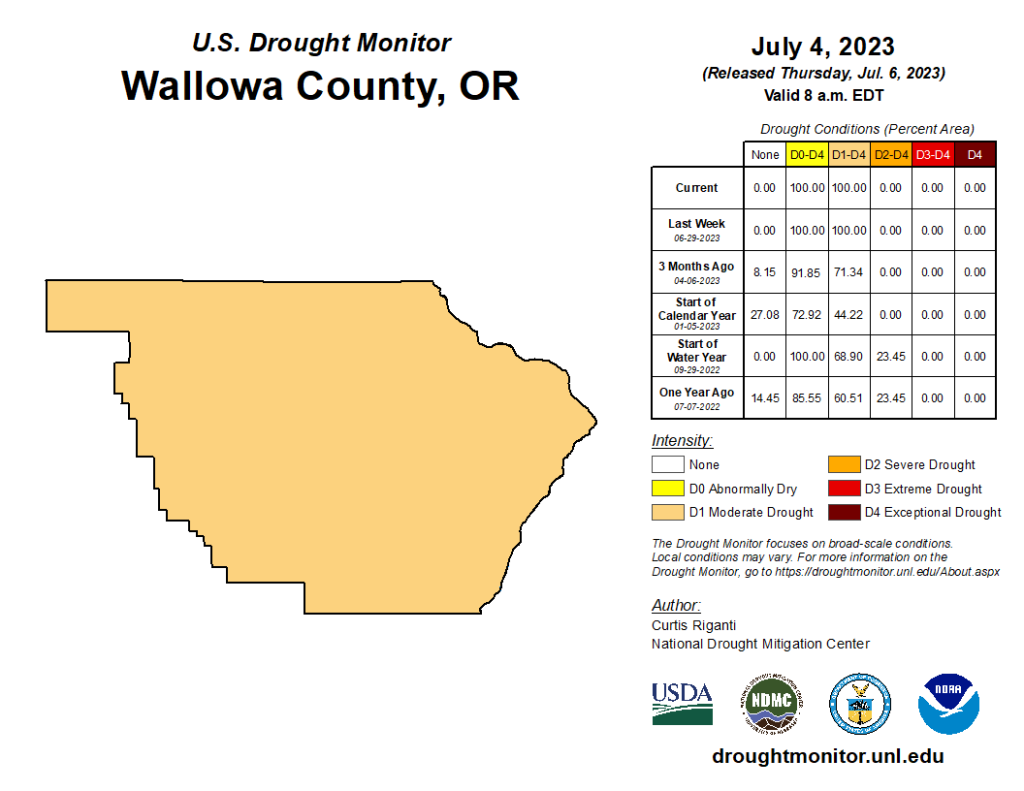Armyworm battle yields optimism in Wallowa County
Published 7:00 am Thursday, July 20, 2023

- 20230704_county41063_trd.png
WALLOWA COUNTY — Crop specialists and producers are working to ensure there isn’t a repeat of last fall’s attack of armyworms, a migratory pest that devastated timothy grass hay crops in Wallowa County.
To do that, they are placing traps that contain pheromones of the female armyworm moths in likely hot spots around the region. The scents emitted by the pheromones will attract male armyworms to the traps and data can be collected from them, said Pete Schreder, livestock, range and natural resource agent for Oregon State University Extension in Wallowa County.
Thus far, Schreder said, results are looking positive.
“So far, so good,” he said. “We’ve got six pheromone traps from Joseph past Wallowa.”
He said crop specialists take the moths captured in the traps to a lab for species identification.
Darrin Walenta, an OSU Extension agronomist with field crop responsibilities for Wallowa, Baker and Union counties, said data gathered from the traps could be useful in predicting when armyworm attacks might occur.
“If we can collect data all season long, it’ll help predict … when the population will hit peak activity levels,” Walenta said.
Schreder said that of the two recognized types of armyworms, there is the “true” armyworm, which generally attacks in late spring, and the fall armyworm, which attacks in late summer and early fall. It was the latter variety that hit last fall.
He said it’s primarily grasses the worms are going after; they avoid dry wheat and legumes.
“They seem to like the fresh, green growth in the timothy,” he said. “They prefer the young, tender growth on timothy and irrigated grass pastures.”
But it’s more than just timothy grass. Wallowa County Commissioner Todd Nash brought up the subject at a commissioners meeting in September 2022, saying he’s done some research on the worms.
“There are about 240 different species of grass they’ll go for,” he said.
Schreder said the worms gobble up the crops quickly.
“Basically, they defoliate them. They eat the leaves, strip the leaves,” he said. “And they do it in a hurry.”
Extent of damage
Schreder said officials never did get an accurate estimate of the extent of the damage from last fall’s attack.
“They’re everywhere,” Scott Shear, who farms near Joseph, said in September.
Dan Butterfield, who runs Butterfield Farms near Joseph, said his farm got hit hard, but the attack just forced him to cut his hay sooner.
“We could find armyworms everywhere we looked,” Butterfield said. “We were fairly well into our harvest, so we just accelerated our cut.”
Butterfield said in July 2023 that he lost all or most of 80 acres in two adjoining fields due to armyworms in 2022. Normally he cuts about 50 acres a day, but because of the urgency created by the worms, he ended up cutting 220 acres in two days and cut three days early.
“We cut everything,” he said. “There was the option to cut or to spray, so we cut.”
He said the spray option came with a drawback in that after spraying, a farmer must wait seven days before harvesting. Also, he said he’s heard that spraying is only moderately successful.
“It doesn’t get all of them,” he said.
Butterfield said his brother, Mark Butterfield, president of the Wallowa County Hay Growers, also got hit hard and cut early.
“He said after three days it was wiping them out so they cut it,” Dan Butterfield said.
Kurt Melville, of Cornerstone Farms Joint Venture and one who reported armyworms last fall, said the attack lasted until the weather froze or the crop was harvested.
“They can’t stand more than a few nights of cold,” he said. “They come up from Texas. When they get to the adult stage, they migrate on when it gets cold.”
Like others, Melville isn’t sure if Wallowa County fields will get hit again.
“Won’t know if we’ll have another bad year until weather warms,” he said.
Cornerstone Farms, which Melville runs along with his father, Tim Melville, and brother, Kevin, lost a bit of timothy grass to the worms.
“We had one timothy field impacted about 25 to 40 percent lost before I was able to swath it and get it put up for hay,” he said.
He said he would’ve waited to cut, but rains came and reduced the value of the crop.
“Based on conversations with growers, all timothy hay producers experienced some level of damage,” Walenta said.
“I want to be cautiously optimistic. So far we’re optimistic this year,” he said, though it may be early. “But we didn’t really get our outbreak last year until growing season.”
Hopes for this year
Farmers and scientists are all hoping to avoid a repeat of last year’s unusual event.
Walenta said he’s met with the Wallowa County Hay Growers and Wallowa County Grain Growers, as well as with individual farmers to discuss measures to detect the worms’ presence and ward off another attack.
“We want to avoid the massive levels of damage,” he said, adding that last year was “a situation that snuck in on us and created the massive devastation.”




